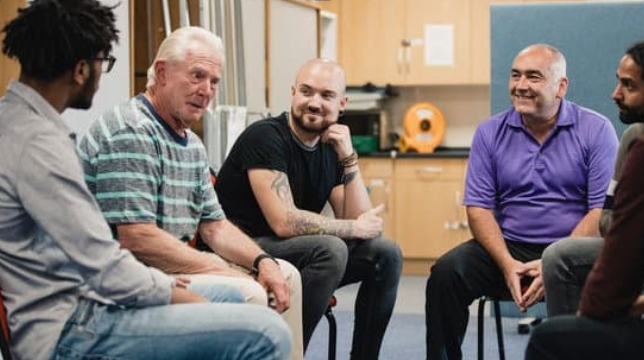
Women seeking addiction treatment in Georgia face barriers that men often don’t encounter: childcare needs, pregnancy-related stigma, limited access to medication programs, and service hours that conflict with caregiving.
Globally, only about 1 in 18 women with drug use disorders receive treatment compared to 1 in 7 men, and Georgia reflects this gap in its own treatment data.
This article explains how gender shapes access, retention, and outcomes in addiction care, and what structural changes could narrow these disparities across the state.
Gender and Addiction Treatment: The Coverage Gap
The treatment system sees far more men than women, but this doesn’t mean men need more help. National data from the Treatment Episode Data Set show that roughly 65% of publicly funded treatment discharges are male. Yet surveys of the general population find that both men and women experience substance use disorders at substantial rates. When women do seek care, they’re more likely to drop out early or face delays getting to appropriate services.
The gap isn’t about need. It’s about access. Women in Georgia and across the country encounter multiple barriers that men typically don’t. Childcare responsibilities, safety concerns in mixed-gender residential settings, stigma around being a mother with addiction, and limited hours at medication clinics all suppress women’s ability to start and stay in treatment.
Georgia’s diverse regions add another layer. In rural counties like Dawson or Berrien, where opioid treatment programs may be hours away, the barriers multiply. Women without reliable transportation or flexible work schedules face impossible trade-offs between treatment and survival needs. Meanwhile, urban areas like metro Atlanta may have more programs, but childcare, program structure, and provider attitudes still determine whether women can walk through the door.
How Gender Shapes Access to Treatment?
Men and women arrive at treatment through different pathways. Criminal justice referrals make up a large share of men’s entries into care, particularly in states with drug courts and probation-linked treatment. Women, by contrast, are more likely to enter through healthcare systems, during pregnancy, through emergency departments after overdose, or via primary care when symptoms become unmanageable.
These different entry points matter because they shape the type of care people receive and how long they stay. Court-mandated treatment often comes with monitoring and consequences for dropout. Healthcare-initiated treatment tends to be voluntary and more fragile, with fewer built-in supports to keep someone engaged when life gets chaotic.
Georgia’s system reflects this pattern. Women who do reach treatment often do so through crisis points, postpartum complications, overdose, or CPS involvement. By then, the disorder is often severe and co-occurring mental health issues are common. Earlier intervention would help, but routine screening in OB-GYN and primary care settings remains inconsistent across the state.
Service design also matters. Programs built around men’s schedules, daytime hours, no childcare, mandatory meetings several nights a week, structurally exclude women who are primary caregivers. Until recently, few Georgia programs offered childcare, lactation support, or flexible scheduling. Some still don’t.
MOUD Access: Where Women Lose Ground?
Medication for opioid use disorder is the standard of care, but not all medications are equally available to women. A 2025 national review found that only about 47% of Medicaid managed care plans cover methadone, despite a federal mandate. In Georgia, this translates to real gaps: women who would benefit from methadone may find their insurance won’t pay for it, or that the nearest clinic is too far for daily dosing.
Methadone requires daily visits to an opioid treatment program, at least initially. For women juggling childcare, employment, and transportation, this can be an insurmountable barrier. Buprenorphine is more flexible, it can be prescribed in an office and taken at home, but research shows women are more likely than men to drop out of buprenorphine treatment. The reasons aren’t fully clear, but stigma and lack of wraparound support likely play a role.

Pregnant and postpartum women face additional challenges. While MOUD during pregnancy improves outcomes and raises retention rates, uptake remains low and uneven by race. Black women in Georgia and across the Southeast have lower rates of MOUD continuation after delivery compared to White women, even when they start medication during pregnancy.
Georgia has taken steps to close this gap. The state now extends Medicaid coverage to 12 months postpartum, a change that should help women stay on MOUD through the highest-risk period for overdose. But coverage alone isn’t enough. Clinics need to offer flexible dosing, integrate with pediatric and OB care, and create environments where women feel safe and supported rather than surveilled.
Retention Patterns Differ by Gender
Staying in treatment long enough to benefit is where gender differences become most visible. Women face pressure to “prove” they’re good mothers by getting off medication quickly, even when clinical guidance says otherwise. Providers sometimes reinforce this, suggesting that MOUD is only a short-term bridge rather than maintenance treatment.
A publicly funded treatment system analysis found that women were less likely than men to drop out of methadone programs but more likely to drop out of buprenorphine treatment. This medication-by-gender interaction suggests that shared decision-making, which matches treatment type to individual circumstances, could improve outcomes. Georgia programs that offer both methadone and buprenorphine, and that involve women in choosing between them, are better positioned to support long-term recovery.
Program structure also affects retention. A 2023 study of an outpatient program found that structured goal-setting and connection to mutual-help groups were the strongest predictors of staying in treatment beyond 90 days. These elements are scalable and could be tailored to women’s needs, for example, peer groups that meet during school hours or that include childcare, and goal-setting frameworks that account for caregiving responsibilities.
| Factor | Men | Women |
| Treatment coverage | ~1 in 7 with disorders receive care | ~1 in 18 with disorders receive care |
| Primary referral pathway | Criminal justice, probation | Healthcare, crisis, pregnancy |
| TEDS discharge proportion | ~65% of discharges | ~35% of discharges |
| MOUD retention on methadone | Higher dropout rates | Lower dropout rates |
| MOUD retention on buprenorphine | Lower dropout rates | Higher dropout rates |
| Structural barriers | Fewer caregiving conflicts | Childcare, pregnancy stigma, safety |
Emerging Risks: Synthetic Opioids and Women
The drug supply is changing in ways that put women at new risk. Nitazenes, synthetic opioids more potent than fentanyl, have appeared in cocaine, MDMA, and other drugs that aren’t typically associated with opioids. People who don’t use opioids regularly, and who don’t carry naloxone or know overdose response, are especially vulnerable.
This matters for gender because women who use stimulants or party drugs socially may not see themselves as at risk for opioid overdose. They may not be connected to harm reduction services or syringe programs where naloxone and drug checking are available. When an unexpected opioid shows up in their supply, the consequences can be fatal.
Georgia’s public health infrastructure varies widely by region. Metro Atlanta and Savannah have harm reduction organizations, but rural counties often don’t. Women in places like Clinch County or Elbert County have limited access to naloxone, drug checking, or overdose education. As synthetic opioids spread, these gaps will widen the gender disparity in overdose deaths.
What Georgia Can Do?
Closing the gender gap in addiction treatment requires deliberate, structural changes. First, the state should enforce Medicaid coverage of methadone and ensure that managed care plans comply with federal mandates. Second, treatment programs should adopt flexible scheduling, on-site childcare, and telehealth options, including audio-only visits, which research shows are essential for patients with limited internet access.
Third, Georgia should expand opioid treatment programs into underserved regions. Counties without a single OTP leave women with impossible choices: travel hours for daily dosing or go without medication. Mobile dosing units and telehealth-enabled buprenorphine could bridge some gaps, but brick-and-mortar OTPs remain necessary for people who need methadone.

Fourth, provider training should address stigma around MOUD, particularly for pregnant and parenting women. Many providers still express discomfort with long-term medication, viewing it as “replacing one drug with another.” Education that emphasizes MOUD as evidence-based, life-saving care can shift these attitudes and improve retention.
Finally, Georgia should integrate addiction screening and treatment into women’s healthcare. Routine screening in OB-GYN and primary care, with warm handoffs to treatment, would catch disorders earlier and reduce crisis-driven entries. Postpartum follow-up that includes SUD care would prevent the dropout that often happens after delivery.
Why Does This Matter?
Gender differences in addiction treatment aren’t just statistics. They translate to real outcomes: women who can’t access care, children who lose parents to overdose, communities that lose nurses, teachers, and neighbors. The data from 2024 and 2025 make it clear that without intentional design for women, treatment systems will continue to serve men better.
Georgia has the tools to change this. The state has extended postpartum Medicaid, allowing 12 months of coverage instead of 60 days. Harm reduction is slowly expanding. Some programs now offer childcare and flexible hours. But these efforts remain scattered and under-resourced.
The next step is to make gender-responsive care the standard, not the exception. That means measuring outcomes by gender, holding programs accountable for retention disparities, and funding the supports, childcare, transportation, peer navigation, that make treatment accessible to women. It means recognizing that a treatment system designed for one gender will fail the other.
If you or someone you care about is navigating these barriers, know that structured, evidence-based care can work when it’s designed to meet people where they are. Gender-responsive programs with peer support and clinical flexibility make the difference between a system that serves everyone and one that leaves half the population behind. Learn more about MARR’s treatment options that support long-term recovery.
